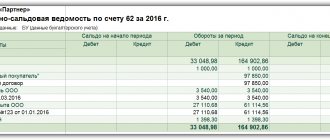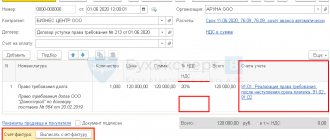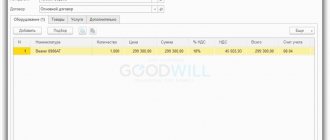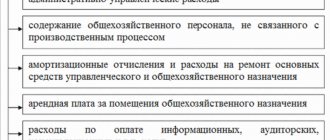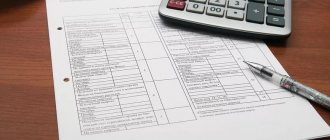Moscow State University of Printing Arts
4.
ACCOUNTS. DOUBLE ENTRY METHOD
4.1.
Task 9. Correspondence of accounting accounts
Based on the data for completing task 7. make accounting entries for business transactions completed during the period.
4.2.
Task 10. Determining the content of business transactions based on their accounting entries
Restore the content of business transactions according to existing transactions (Table 4.1):
Table 4.1
Correspondence of accounting accounts
| No. | Contents of a business transaction | Wiring | |
| Dt | CT | ||
| 1 | 23 | 70 | |
| 2 | 20 | 28 | |
| 3 | 70 | 50 | |
| 4 | 51 | 66 | |
| 5 | 70 | 68 | |
| 6 | 20 | 69 | |
| 7 | 69 | 51 | |
| 8 | 68 | 51 | |
| 9 | 50 | 51 | |
| 10 | 20 | 10 | |
4.3.
Task 11. The relationship between the accounting accounts and the balance sheet for the reporting period
- 1. Draw up the balance sheet of the enterprise as of November 1, 200_ according to the data given in table. 4.2.
Table 4.2
Account balances as of November 1, 200_
| Name of accounts | Amount, thousand rubles |
| Materials | 6000 |
| Settlements with suppliers and contractors (accounts payable) | 1000 |
| Checking account | 25000 |
| Cash register | 500 |
| Payments to personnel regarding wages | 2000 |
| Finished products | 1000 |
| Authorized capital | 70000 |
| Calculations with accountable persons | 200 |
| Reserve capital | 1700 |
| Fixed assets | 42000 |
- 2. Make the necessary accounting entries for the business transactions listed in table. 4.3.
Table 4.3
Journal of registration of business transactions for November 200_.
| Contents of operations | Wiring | Amount, thousand rubles | |
| D-t | Kit | ||
| 1. Materials received from suppliers are received into the warehouse | 1300 | ||
| 2. Transferred to pay suppliers' bills | 2000 | ||
| 3. Materials were released to the main production for the manufacture of products | 1650 | ||
| 4. Wages accrued to workers of the main production for the manufacture of products | 3000 | ||
| 5. Materials not used in production were returned to the warehouse | 120 | ||
| 6. Materials purchased by an agent of the logistics department at the expense of accountable amounts | 130 | ||
| 7. The unreturned balance of accountable amounts is withheld from the agent’s salary | 70 | ||
| 8. Received at the cash desk for payment of wages and travel expenses | 5130 | ||
| 9. Issued: | |||
| 9.1. staff salaries | 4930 | ||
| 9.2. under the director's report for business trip expenses | 180 | ||
| 10. The excess amount received for travel expenses was deposited into the current account | ? | ||
| 11. Finished products are delivered to the warehouse from production | 1500 | ||
- 3. Based on the data in tables 4.2 and 4.3:
- open accounting accounts;
- reflect business transactions in the accounting accounts using the double entry method;
- calculate revolutions and final balances.
4. Based on the data from the final account balances, draw up a balance sheet as of December 1, 200_.
4.4.
Task 12. Reflection of business transactions in accounting
Based on the balance sheet at the beginning of the reporting period, compiled according to task 6, open the necessary accounting accounts, record the transactions for the month in them, display the final balances and draw up the final balance in Form No. 1 “Balance Sheet” (Appendix 1) and the turnover sheet.
Table 4.4
Journal of registration of business transactions for _______200_.
| Contents of operations | Wiring | Amount, thousand rubles | |
| D-t | Kit | ||
| 1. By check received at the bank for business needs and for the payment of wages | 300 | ||
| 2. The buyer's debt has been credited to the bank account. | 1250 | ||
| 3. Suppliers’ invoices for materials received were paid from the current account | 645 | ||
| 4. Partially repaid a short-term bank loan | 290 | ||
| 5. Materials received from the supplier have been capitalized | 420 | ||
| 6. Materials written off for the needs of the main production | 500 | ||
| 7. Debt to social insurance authorities was transferred from the current account | 65 | ||
| 8. According to advance reports, the debt of accountable persons is included in the proceedings | 3 | ||
The decision should be made on the charts of accounts (Table 4.5) and in the turnover sheet (Table 4.6) in the following form:
Table 4.5
Account number and name
| Dt | CT |
| Turnover | Turnover |
Table 4.6
Turnover sheet for synthetic accounts for _______ 200_ g.
| Account number | Balance at the beginning of the period | Turnover for the period | balance at the end of period | |||
| Dt | CT | Dt | CT | Dt | CT | |
| 01 | ||||||
| 02 | ||||||
| ….. | ||||||
| ….. | ||||||
| ….. | ||||||
| ….. | ||||||
| ….. | ||||||
| TOTAL | ||||||
4.5.
Task 13. Synthetic and analytical accounting accounts
On the accounts of synthetic and analytical accounting, reflect account balances (Table 4.7), transactions for the month (Table 4.8); reconcile analytical and synthetic accounting using turnover sheets; display the balances at the end of the month.
Table 4.7
Account balances as of March 1, 200_
| Name of accounts | Amount, conventional den. units |
| Materials | 30000 |
| including: | |
| 15000 |
| 10000 |
| 5000 |
| |
| black paint 200 kg, 10 units. den. units | 2000 |
| red paint 200 kg. 15 conventional units den. units | 3000 |
| Checking account | 60000 |
| Settlements with suppliers and contractors | 25000 |
| including: | |
| 12000 |
| 7000 |
| 6000 |
Table 4.8
Journal of registration of business transactions for March 200_.
| Contents of operations | Wiring | Sum | |
| D-t | Kit | ||
| 1. The bills of the “Leader” association were paid from the current account | 10000 | ||
| 2. Bills were paid from the current account | 500 | ||
| 3. Invoices of Kolor LLC for incoming paint were accepted: -black paint 300 kg, 10 units. monetary units; - red paint 260 kg, 15 units. monetary units | 3000 3900 | ||
| 4. The bills of Kolor LLC were paid from the current account | 13000 | ||
| 5. The following items were released to the printing shop from the warehouse: — black paint 400 kg, 10 units. monetary units — red paint 250 kg, 15 conventional units. den. units | 4000 3750 | ||
| TOTAL | 42750 | ||
Open analytical accounting cards for each type of material and for each supplier.
Account scheme 40817 “Individuals”
Table 1.
| Corresponding account | Transactions reflected in the debit of account 40817 | Transactions reflected on the credit of account 40817 | Corresponding account |
| Account credit | Initial balance (CH ) – the balance of funds on the card account of a client – an individual. | Account debit | |
| 20202 | Receiving funds at the cash desk of the card issuing bank (cash withdrawal). | Depositing funds by an individual at the cash desk of the bank that issued the payment card. | 20202 |
| 20208 | Receiving cash from ATMs and payment terminals of the same bank (issuing bank). | Transfer of funds to the card from a deposit account opened in the same bank. | 42301-42307 |
| 30233 | Receiving cash from ATMs and payment terminals of other banks (participants of the same payment system). | Crediting the salary amount if the employer's account is opened in the same bank. | 401-408 |
| 45501-45510 | Payment of the principal debt on a previously taken out loan from the same bank | Receipts of payments from other banks to the card account. | 30102 |
| 70601 | Interest payments on a previously taken loan from the same bank. | Providing a loan by credit card or crediting the loan currency in accordance with the loan agreement. | 45501-45510 |
| 30233, 30232 | Purchasing goods, works and services in retail establishments. Transfer to clients of other banks. | Depositing funds from cardholders at the payment terminal of the same bank. | 20208 |
| 40817 | Transfer of funds to a client of the same bank. | Depositing funds in cash by the cardholder at ATMs and payment terminals of other banks (participants of the same payment system). | 30233, 30232 |
| 70601 | Payment of commissions and other payments to the bank for services. | Crediting the ruble equivalent when a client-card holder sells foreign currency. | 47405 |
| 47405 | Transfer of ruble funds for the purchase of foreign currency in the same bank. | Crediting the client with the ruble equivalent from the sale of precious metals from an unallocated metal account. | 20309 |
| 20309 | Purchase by the client of precious metals for crediting to an unallocated metal account in the same bank. | Crediting the client with funds from the sale of his securities on the stock market. | 47403 |
| 47403 | The client purchases securities on the stock market. |
Errors in primary documents
First of all, the source documents must contain correctly specified mandatory details. According to the Ministry of Finance, a taxpayer can take into account expenses on the primary tax return if it contains only minor errors.
Such errors should not interfere with the accurate identification of the seller and buyer, the name of the goods and their value, and other circumstances of the documented fact of economic life (from the letter of the Ministry of Finance dated February 4, 2015 No. 03-03-10/4547).
Unfortunately, the typical streamlined formulation of officials’ explanations often does not make it possible to clearly understand which inaccuracies or errors in the primary documents will be considered insignificant.
For example, is it a minor error if a taxpayer's name is in lowercase letters instead of uppercase letters? In another letter, dated 05/02/2012 No. 03-07-11/130, the Ministry of Finance indicated that errors such as replacing capital letters with lowercase ones and vice versa; reversing letters; incorrect indication of the organizational and legal form is not an obstacle to identifying the taxpayer (if the TIN and other details are correctly indicated).
But the following errors can be considered significant for primary documents:
- arithmetic errors (the price/quantity of the product or the tax amount is indicated incorrectly);
- different names of the same product (for example, in the specification for the supply contract the candies are called “Waffle candies in chocolate”, and in the invoice - “Bear in the North”);
- inaccurate job titles of those who sign the primary documents (for example, the power of attorney states “Deputy General Director”, and the acceptance certificate states “Deputy Director”);
- the amounts in figures do not coincide with the same amounts indicated in words (instead of 155,000 rubles (one hundred and fifty-five thousand rubles), 155,000 rubles (fifty-five thousand rubles) are written).
The tax office may not accept expenses for such primary documents; the counterparty may also have problems when deducting VAT.
Primary documents can only be corrected using the proofreading method (incorrect text is crossed out with one thin line, and the correct text is written on top). Corrections are accompanied by the inscription “Corrected”, the date and signatures of the responsible persons. Corrections of incoming and outgoing orders, bank documents and BSO are unacceptable. They need to be compiled anew.
Pay attention to the fact that the primary documents are signed during the validity period of the power of attorney issued for their signing, otherwise the inspectors will consider that the documents were signed by an unauthorized employee. The same thing needs to be monitored regarding the signatures on your primary document of representatives of counterparties: the powers of attorney issued to them must be current.
When preparing primary documents, you need to be careful not only about filling them out, but also about the correspondence of their dates and other details with other documents, for example, contracts and invoices. Thus, the deduction of VAT on an invoice drawn up earlier than the delivery note will be controversial.
Questions from the tax authorities will be raised by invoices or acts signed earlier than the agreement, the execution of which is confirmed by primary documents. There is a way out of this situation, provided for in paragraph 2 of Art. 425 of the Civil Code of the Russian Federation: indicate in the text of the agreement the following clause: “The terms of this agreement also apply to the relations of the parties that arose before its conclusion.”
Or, for example, the act states that the work was completed in the period from March 10 to March 30, while in the contract the period of work is set as from April 10 to April 30. In this case, you can draw up an additional agreement to the contract, which indicates the actual deadline for completing the work or indicates in the act itself that the work was completed ahead of schedule.
Contractors need to be careful when the customer signs work completion certificates. If subcontractors were involved under the contract, the contractor must sign agreements with them before the work is handed over to the customer. If these dates do not correspond, tax authorities may consider the costs of the subcontractor unjustified and not recognize them when calculating the tax base.

